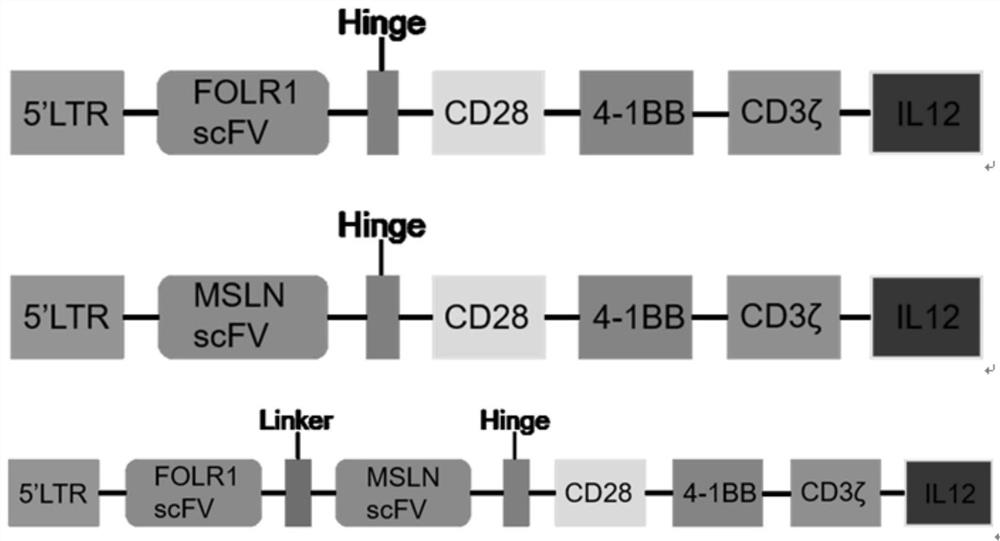Folr1-msln dual targeting CAR-T cells, chimeric antigen receptors and vectors for the treatment of ovarian cancer
A chimeric antigen receptor and single-chain antibody technology, applied in the fields of immunology and molecular biology, can solve the problems of insufficient T cell persistence, difficult T cell infiltration, easy recurrence, etc.
- Summary
- Abstract
- Description
- Claims
- Application Information
AI Technical Summary
Problems solved by technology
Method used
Image
Examples
Embodiment 1
[0051] Embodiment 1 lentiviral vector construction
[0052] 1. Construction and verification of plasmid vectors
[0053] 1. The construction process of the recombinant plasmids FOLR1-CAR, MSLN-CAR and Tandem-CAR: use the gene synthesis method of PCR bridging to artificially synthesize CD8 signal peptide, single-chain antibody (FOLR1-scFv or MSLN-scFv or Tandem-scFv ), CD8a hinge region, CD28-41BB-CD3z CAR structure, IL-12 gene sequence, introduce XbaI enzyme cutting site in its upstream, and insert NotI enzyme cutting site in its downstream, entrust Beijing Qingke Biological Company to synthesize and load it into In the pCDH vector (purchased from Addgene) double-digested with XbaI and NotI,
[0054] PCDH.
[0055] 2. Extract a large amount of plasmid pCDH
[0056] 1) Take a small amount of frozen glycerol bacteria and inoculate them on LB solid culture plates containing Amp resistance, and place them in a 37°C incubator for overnight culture.
[0057] 2) The bacteria were...
Embodiment 2
[0119] Embodiment 2 separates PBMC and CD3
[0120] 1. From the PBMC
[0121] 1) Collect 10ml of peripheral blood from healthy volunteers, put it in an ice box immediately, bring it back to the cell room in the laboratory, wash it with PBS three times, and add 10ml of PBS+2%FBS buffer.
[0122] 2) Density gradient centrifugation: add 15ml of Stemcell Ficoll solution, centrifuge at 1500rpm, 19°C for 30 minutes, after centrifugation, it can be seen that the tube is divided into 4 layers: the uppermost layer is plasma, containing some platelets; the second layer is a thin white film layer, mainly mononuclear cells, mixed with a small amount of platelets; the third layer is the separation liquid layer; the fourth layer is granulocytes and red blood cells. A thin white film.
[0123] 3) Carefully absorb the buffy coat cells, add 5 times of PBS solution to the obtained PBMCs, gently pipette evenly with a capillary pipette to avoid the production of small air bubbles, and the heigh...
Embodiment 3
[0135] Example 3 lentivirus infection of CD3 and determination of infection results
[0136] 1. Infect CD3 cells per well with a multiplicity of infection (MOI) of 10, add polybrene 8ug / ml, and infect.
[0137] 2. APC-F(ab') after 72 hours of infection 2 Staining, detection of infection rate by flow cytometry.
[0138] 3. Experimental results
[0139] The 4th generation FOLR1-CAR plasmid, MSLN-CAR plasmid and Tandem-CAR plasmid, the structure diagram is shown in figure 1 , the constructed plasmid was digested, and the nucleic acid gel electrophoresis analysis conformed to the size of the target gene fragment. At the same time, we sequenced and verified the three plasmids, and the sequences were correct, indicating that three lentiviral plasmids containing two co-stimulatory molecules CD28 and 4-1BB and IL-12 gene were successfully constructed.
[0140] CD3 cells were infected with MOI=10 for 5 days, and the results of flow cytometry showed that the expression of CAR was 40%,...
PUM
 Login to View More
Login to View More Abstract
Description
Claims
Application Information
 Login to View More
Login to View More - R&D
- Intellectual Property
- Life Sciences
- Materials
- Tech Scout
- Unparalleled Data Quality
- Higher Quality Content
- 60% Fewer Hallucinations
Browse by: Latest US Patents, China's latest patents, Technical Efficacy Thesaurus, Application Domain, Technology Topic, Popular Technical Reports.
© 2025 PatSnap. All rights reserved.Legal|Privacy policy|Modern Slavery Act Transparency Statement|Sitemap|About US| Contact US: help@patsnap.com



